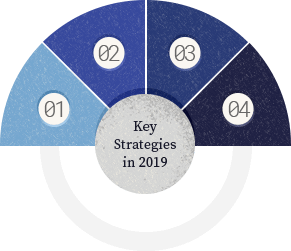FOOD INDUSTRY DEVELOPMENT AND MARKET TREND ANALYSISAnalysis of Food Industry Development and Market Trends
Slowing industry growth
Rapid global economic changes have led domestic and foreign demands to shrink, leading companies to take a more conservative stance. The scale of the market remains relatively constant, and production values remain largely unchanged from industry to industry.
Changes in population structure and eating habits
The market has become more segmented and niche, with a preference for customization, convenience, and social community Population aging has led to changes in consumers' dietary habits and preferences. People are increasingly focused on health while searching for taste. In addition, people are also beginning to pay attention to environmental impacts from product life cycle, and more attention is being paid to sustainable products.
Growing demand for delivery services and frozen foods
Besides significant changes in the structure of food products, the convenience from delivery services is also gaining more popularity in Taiwan, while high-quality frozen foods market also remains popular.
Inflation in pork prices
Compared to 2018, poultry prices have risen by 2.34% in Taiwan in 2019. The inflation was mostly attributable to the continuing African Swine Fever in China, which led to significant decreases in pork production and impacted global pork and other livestock markets and thereby increasing Taiwan's pork prices.
Digital community and hybrid management in brand collaborations
With the development of digital tools and social networks, consumers are also becoming more independent and willing to voice their opinions. Businesses are also actively attracting target groups and developing business opportunities through forming joint collaborations and hybrid business models.
CHALLENGES AND OPPORTUNITIESChallenges and Opportunities
Impacts from international community made raw material prices more difficult to manage
Intense competition among retail businesses has shrunk market profitability
Safe and Quality Products; Traceable Ingredients Management
Develop Diverse Core Products to Meet Market Demand
Develop Special Channels to Expand Market Share

Set Annual
Operating Strategies
- ‧Convene annual senior management team meetings
- ‧Analyze internal management status and external risks and opportunities
- ‧Establish response measures for each business division
Impacts from international community made raw material prices more difficult to manage
- In a globalized economic system, input prices of raw material are more prone to impacts from international conditions, policy changes, economic fluctuations, and the outbreak of diseases.
- Price fluctuations are difficult to predict, presenting an unfavorable factor against cost control and development.
Intense competition among retail businesses has shrunk market profitability
- By adopting management strategies including forming local and overseas partnerships, agency, and developing own-brands, hypermarkets and chain stores have expanded their market shares through purchasing, pricing and channel advantages, thereby shrinking the profitability of other retailers and food companies.
Safe and Quality Products; Traceable Ingredients Management
- We are committed to the quality of product development, and all product development efforts are focused on safety, while all merchandise sold comply with relevant food and safety laws.
- We implemented food safety monitoring program and factory inspection plan to continuously safeguard both quality and safety.
Develop Diverse Core Products to Meet Market Demand
- Developed creative tastes, healthy, exciting, unique, and local small farm products from our existing product lines.
- Interdisciplinary collaboration marketing was carried out by either partnering with other companies or by acquiring authorized images to satisfy the customers' rapidly changing demands.
Develop Special Channels to Expand Market Share
- Organized joint creative marketing activities at the highway service area to strengthen their unique characteristics and to differentiate the service areas.
- By understanding customers' purchasing records via data and technology, we further enhanced passenger satisfaction by improving service contents and implementing training and management.
- The airport stores were designed along the conception for an airport shopping mall that includes foods, shopping, arts and crafts, and souvenirs from all around Taiwan. Besides satisfying the passengers' shopping needs, we can also bring quality Taiwanese brands to the rest of the world.
BUSINESS STRATEGYOperating Strategies
Hsin Tung Yang organizes management conferences in each year to review the operating status of each business division. The overall economic environment, current food industry environment and developments, and market supply/demand and growth opportunities are analyzed, and risks and opportunities in developing our visions are also clarified, thus allowing us to form response strategies for each business division and an annual business plan to ensure the sustainable management of the Company. To respond to the aforementioned external trends and opportunities, Hsin Tung Yang will propose short- and long-term business development plans for channels and products and to conduct timely performance review and propose strategies accordingly. We will seize opportunities to create business value through our core strengths, and to maintain sound after-tax net profit.


Product management
- Developed client OEM market
- Enhanced productivity and reduced costs
Business channel management
- Developed product management
- Integrated channels with our online platform
- Sought for OEM of own-brand products from various channels
Channel management
- Strengthened customer management by being tech-savvy and data-driven
- Enhanced brand value via creative channel services
Marketing efforts
- Increased member interactions
- Adopted precision marketing via data
- Generated buzz to achieve continuous brand exposure
- Reinforced localized and unique characteristics of channels
Strategies
Strategies
Channel Strategies
- Continued to expand business locations
- Introduced creative services and differentiated products based on the nature of the channel.
- Encouraged the management officers to develop professional skills and enhanced quality and professionalism in service personnel.
Acquire insights to consumers' diverse needs
By partnering our own channels with various industries, we can understand changes in consumer movements, purchasing behavior, and trends at each channel.
Enhance members' experiences and loyalty
By optimizing our smartphone app, we can strengthen interactions between members and increase customer adhesion. By understanding customer profile and consumer history, we can develop new retail through customer flow analysis system, and technology can also be used to enhance management effectiveness and precision marketing.
Promote creativity in merchandise and services
Enhance brand value by building diverse, fun, and thoughtful consumer experiences based on the nature of the channels.
Connect local small farmers to build a sustainable value chain
Nurture local small farmers and develop a platform between the farmers and consumers, where local agricultural specialties, foods, and ingredients can be introduced to each channel to realize a sustainable supply and demand system with unique local features, thereby enhancing the overall value of Taiwan's green industry.
Create hot topics and trends via social media
We communicate with consumers via emerging and diverse media models, and also increase exposure through buzz marketing.
Product Strategies
- Developed products based on market trends and target customer groups
- Launched optimized marketing plans based on the nature of channels and products
- Planned product launch for various channels to increase market share
- Utilized strengths in procurement and production technologies and continued to develop OEM market to enhance productivity and reduce cost
Understanding the needs of target consumers
Develop LOHAS, recreational, healthy, and age-friendly delicacy by analyzing consumption models and market trends. In addition, we can also enhance product quality and management through implementing the latest technologies and ingredients.
Strengthening segmentation by including local characteristics
We can generate buzz and enhance contents of products through collaborating with local farmers, and enhance visibility through channel and diversified marketing, thereby strengthening brand image and product value and increase consumer preference and recognition.
Continuing to Enrich Every Moment of Our Lives Through Flavor







